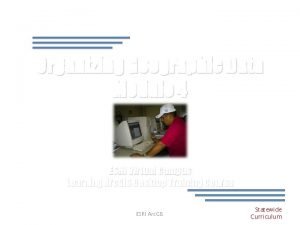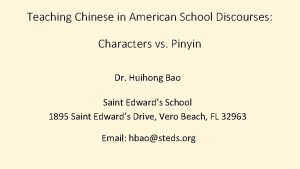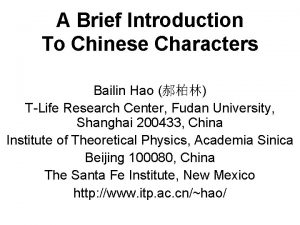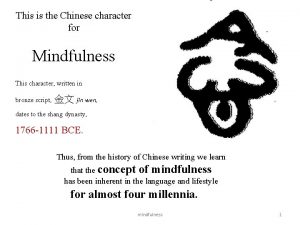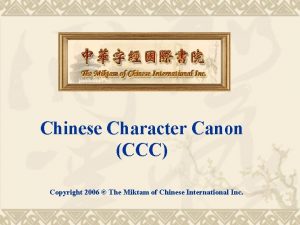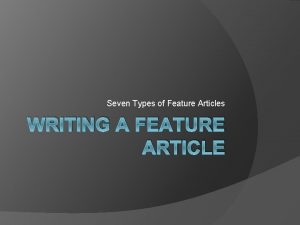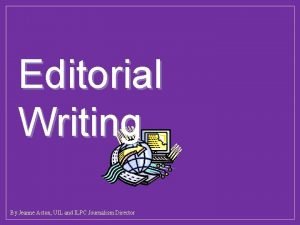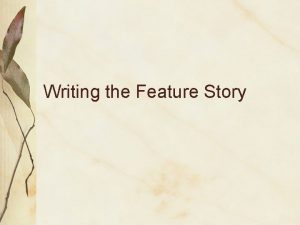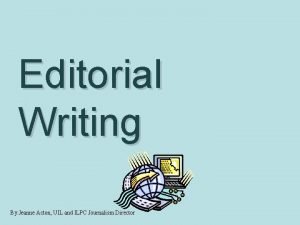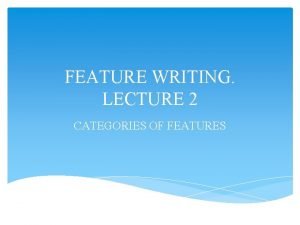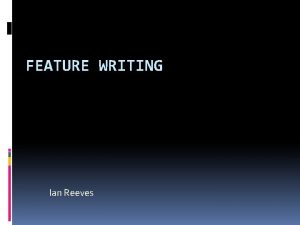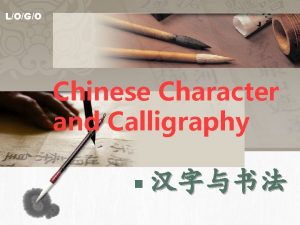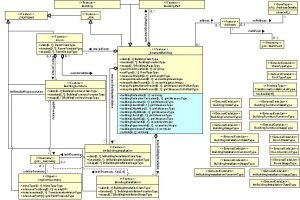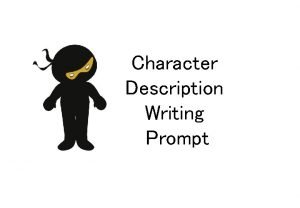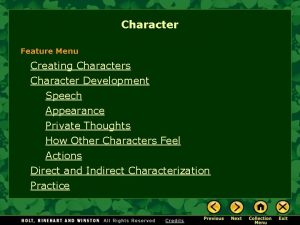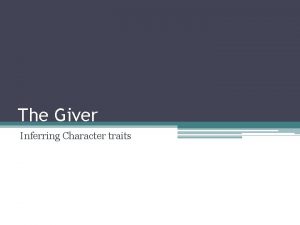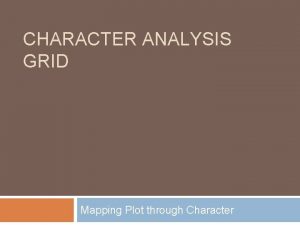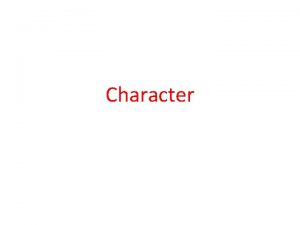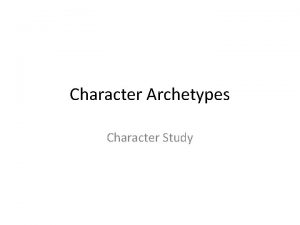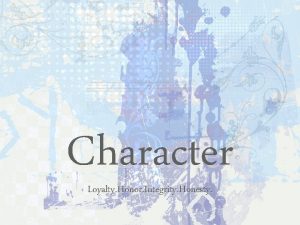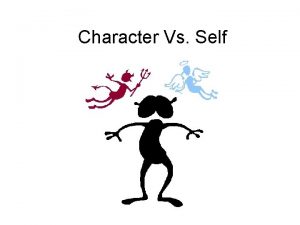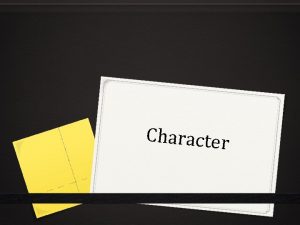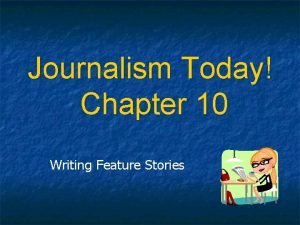Chinese writing 1 The feature of Chinese Character

















































- Slides: 49

中国的文字 Chinese writing 1

§ 一. 汉字的特点 The feature of Chinese Character § 二. 汉字的构造方式 The construction of Characters § 三. 汉字的发展演变 The development of Characters 2

Pictogram / Hieroglyphs § § § 鱼 fish 3


§ § 山 mountain 5

鳥 鸟 bird 6

休 rest 7

In Egyptian hieroglyphics, the determinative is a glyph that carries no phonetic value but instead is added at the end of a word to clarify the meaning of the word. This is due to the fact that the writing system does not record vowels, and therefore different words with the same set of consonants (but different vowels) can be written by the same sequence of glyphs. Therefore the determinative became necessary to disambiguate the meaning of a sequence of glyphs 8

§ Pictograph and ideograph § hieroglyphs。 § The basic unit of Chinese is strokes, 如:ノ+丨=亻;一+ 丨+丿+乀=木;亻+木=休 9

Formation of words § “六书”the six categories of characters: 象形、指事、 会意、形声、转注、假借. But there are only four ways to form a word, the other two ways are simply how to use words; Ø 象形 pictogram Ø 指事 indicative Ø 会意 combined ideogram Ø 形声 pictophonetic 10

§ “象形”pictograph 日 sun 11

月 moon 12

水 water 13

門 门 door 14

鹿 deer 15

雨 rain 16

宫 palace 17

木 tree 18

子 child 19

身 body 20

§ “指事” indicatives or ideogram 丄 上 21


本 Original meaning: root Extended meaning: basic; fundamental; original 23

刃 Meaning: the edge of a knife, sword, etc 24

“会意” Combined ideogram: putting together several pictographs to construct an abstract idea; 森:Chinese often use “three” to indicate “many”. So three “木” means there a lot of trees. The woods, in Chinese , we call it “森林” 众:three “people” 人 means crowd or mob 明: Using the sun and the moon, to indicate bright or brilliant. 明亮、光明 25

寇:“宀” sinifies a house,“元” is a person,“ 攴”means stick in somebody’s hands. So from this character we know that someone breaks into one’s house and robs. The meaning of “寇” is robber。 26

寒:ha n, the two dots at the bottom represent ice, indicating it’s cold inside the house, and straws used to keep people warm. Together the word 寒冷”means cold 27

家: jia , in an agricultural society, it was important to have domesticated pigs; they were a status symbol. Therefore, the Chinese word for family consists of a roof on top and a pig at bottom. 28

集:ji , birds perk on a tree denote the idea of gathering; collecting, and by extension: 集市:ji shi : country fair 集团:ji tua n: group 诗集:shi ji : a collection of poems 29

§ In modern Chinese, there are many words coined or formed by putting together ideographs; for example: § 歪:wai , (not upright) inclined § 泪:lei , (water in the eyes) tears § 众:zho ng, (many people) crowd, mob § 尖:jia n, (small over big) tip § 灭:mie , (dirt over fire) extinguish § 尘:che n, (small dirt) dust 30

§ 形声:picto-phonetic formation combines the pictographic symbol with the phonetic one to signify both the meaning and pronunciation of a word. § For example, “山旁必言山,水旁必言水”the mountain radical connotes relations to mountains while the water radical water. e. g: 31


莫 暮 莫 (mo ): It’s original meaning is dusk. Since its pronunciation is similar to “nobody”, and it’s too hard to make a character for “nobody”. So we use “莫” to indicate “nobody”, and make an other character “暮”(mu ) for dusk. 33

§ 1. Radical“犭”stems from(犬, qua n)meaning dog,and appears in such animal related words as: 狗 (go u, dog)、 猫 (ma o, cat)、狼 (la ng, wolf)、狐狸 (hu li, fox)、猪 (zhu , pig)、狮 (shi , lion)、狡猾 (jia o hua , conniving)、狠 (he n, cruel); § 2. Ridical“饣”originates from the word 食 (shi , eat) and appears in such food related words as 饭 (fa n, food)、饿 (e hungry)、饱 (ba o, full)、饼 (bi ng, pancake)、饲 (si , feed)、 饺 (jia o, dumpling)、馒 (ma n, steamed buns)、餐馆 (ca n gua n, restaurant); § 3. Radical“宀”(ba o gai ) appears in such words related to houses and dwelling spaces as: 家 (jia , family)、宅 (zhai , house)、安 (a n, peace)、客 (ke , guest)、室 (shi , room)、宾 (bi ng, guest)、宫 (go ng, palace)、宿 (shu , dorm)、富 (fu , prosper)、公寓 (go ng yu , hotel/apartment)、宽 (kua n, wide); 34

§ 4. Radical“扌”(ti sho u) is always present in actionrelated words such as: 打 (da , hit)、扔 (re ng, toss)、扶 (fu , support)、扫 (sa o, sweep)、摸 (mo , touch)、抖 (do u, handle)、折 (chai , dismantle)、抢 (qia ng, seize)、护 (hu , protect)、拥抱 (yo ngba o, embrace); § 5. Radical“心、忄”appears in all words having to do with moods, feelings and human psyche, such as 思想 (si xia ng, think)、怀念 (huai nia n, memorize fondly)、忍 (re n, endure)、愤怒 (fe nnu , anger)、恨 (he n, hate)、怕 (pa , afraid)、急 (ji , in a hurry); § 6. Radical“疒” signifies sickness and appears in such words as 疾病 (ji bi ng, ailments)、癌症 (ai zhe ng, cancer)、疼痛 (te ng to ng, pain)、痒 (ya ng, itch)、瘦 (sho u, under-nourished)、痕 (he n, bruise)、痘 (dou , mole); 35

§ 7. Radical“月”signifies flesh and appears in such words related to physical parts of the human body as: 胳膊 (ge bo, arms)、腿 (tui , leg)、脚 (jia o, foot)、肌肉 (ji rou , muscle)、肚 (tu , stomach)、肠 (cha ng, intestines)、肤 (fu , skin)、脸 (lia n, face)、肩膀 (jia nba ng, shoulders)、肥 (fei , fat)、肺 (fei , lungs)、背 (bei , back)、胖 (pa ng, obese)、胸 (xio ng, chest); § 8. Radicals“讠”(言字旁)and “口”signify speech and mouth, often appear in such words as 说 (shuo , speak)、话 (hua , langauge)、读 (du , read)、记 (ji , record)、讨论 (tao lu n, discuss)、议 (yi , talk)、讲 (jia ng, conversation)、许 (xu , permit)、谜语 (mi yu , riddle)、吹 (chui , blow)、吵 (cha o, quarrow)、喊 (ha , yell)、叫 (jia o, shout)、吓 (xia , threaten)、 吸 (xi , inhale)、吞 (tu n, swallow)、听 (ti ng, listen)、吻 (we n, kiss); 36

§ 9. Radicals“钅” and “金”indicate metals and appear to such words as 针 (zhe n, needle)、钉 (di ng, nail)、钓 (go u, hook)、钢 (ga ng, steel)、铁 (tie , iron)、钱 (qia n, money); § 10. Radical“衤、衣”is clothe radical and often present in such related words as: 衬衣 (che n yi , under harments)、裤 (ku , pants)、袋 (dai , pockets)、袖 (xiu , sleeves)、被 (bei , blankets)、 裙 (qu n, skirt); § 11. “氵”is a water radical and appears in such water-related words as 河 (he , river)、流 (liu , flow)、江 (jia ng, river)、湖 (hu , lake)、海 (hai , ocean)、汽 (qi , steam)、泪 (lei , tears)、沉 (che n, sink)、游泳 (yo u yo ng, swim)、汤 (ta ng, soup); § 12. “贝”is seashell, which was often used in ancient times as currency, and present in such words as: 贵 (gui , expensive)、 赔 (pei , compensate)、费 (fei , fees)、财 (cai , wealth)、贡 (go ng, tribute)、赏 (sha ng, gifts/awards)、赌 (du , gamble)、购 (gou , purchase)、债 (zhai , debt)、货 (huo , goods)、贼 (zei , thief)、赚 (zhua n, profit)、 37

三. Three periods of Development § 1. Seal Script(篆体 zhua n) Ø Greater and lesser seal § § 2. Official or clerkly script(隶体 li ) 3. Regular Script(楷体 kai ) 4. Running Script (行书 xing) 5. Cursive or grass script (草书 cai) 38

篆 体 zhua n style § The period lasted about 1200 years, from 1400 B. C. to 206 B. C. when Qin Dynasty came to an end; § The period included the Yin dynasty, Zhou dynasty and Warring States in which writing appeared on turtle bones (for oracle divination) and bronze vessels (for records and rituals or affairs of the State). 39





§ 小篆:small seal was the official script after the unification of China (B. C. 221); prior to that, there had been various writing styles, systems of measurement and standards of currency. To better rule the country, the emperor decided to“ 书同文、车同轨、统一度量衡”(“write the same language, standardize vehicle axles, and make uniform benchmarks of measurement). Small or lesser seal script became the standard. § 隶体/隶书: official script originated in the warring states period prior to the unification and was a popular writing style until the period of the Three Kingdoms, lasting about 500 years (221 B. C. ~ 300 A. D. ) 44


§ 隶书:At the time of unification, there were strict laws and criminal offenses that generated massive paper work for prison wardens. To speed up the processing time, the wardens had to develop the small seal script into what was later to be recognized as “official script”. This was nothing less than a revolution in the history of Chinese writing, referred to as the “reform of li scrpt” (隶,slaves). § 秦始皇统一时期,国家的法律非常严格,许多人被关到了监狱 里,狱吏每天要处理大量的案件。为了能节省时间,更快速地 记录下每个案件的审理过程,狱吏们慢慢开始使用一套不同于 小篆的写法。这种写法简单方便,对小篆做了很大程度的改变, 这就是隶书。隶书在汉字的发展史上有着非常重要的作用,是 汉字的一次革命。从小篆变为隶书,俗称“隶变”。隶变使汉字 进一步脱离了图画的性质,变为了纯符号的文字。 46

楷 体 § Regular script, known as “kai”style, began in Eastern Han (200 A. D. )and became widely adopted during the Sui, Tang and Song dynasties. Even today, over 1600 years later, people still use the script when they write formally. § 楷书起于东汉末,通行于隋唐,经过宋元一 直到今天,已经有1600年以上的历史了。 47

行 书 Running script 48

草书 Cursive or grass script 49
 Feature dataset vs feature class
Feature dataset vs feature class Isolated feature combined feature effects
Isolated feature combined feature effects Anglo chinese school chinese name
Anglo chinese school chinese name Most complicated chinese character
Most complicated chinese character Hao chinese character
Hao chinese character Chinese character for mindfulness
Chinese character for mindfulness Miktam definition
Miktam definition Flat character in american born chinese
Flat character in american born chinese Article writing features
Article writing features Example of a personality feature story
Example of a personality feature story Personal sketch feature writing
Personal sketch feature writing Feature news example
Feature news example Editorial writing examples
Editorial writing examples Stacatto lead
Stacatto lead Leaguetown high school
Leaguetown high school Narrative writing features
Narrative writing features Scope of feature writing
Scope of feature writing What is feature writing
What is feature writing Structure of feature story
Structure of feature story Hình ảnh bộ gõ cơ thể búng tay
Hình ảnh bộ gõ cơ thể búng tay Lp html
Lp html Bổ thể
Bổ thể Tỉ lệ cơ thể trẻ em
Tỉ lệ cơ thể trẻ em Chó sói
Chó sói Chụp phim tư thế worms-breton
Chụp phim tư thế worms-breton Chúa yêu trần thế alleluia
Chúa yêu trần thế alleluia Các môn thể thao bắt đầu bằng tiếng đua
Các môn thể thao bắt đầu bằng tiếng đua Thế nào là hệ số cao nhất
Thế nào là hệ số cao nhất Các châu lục và đại dương trên thế giới
Các châu lục và đại dương trên thế giới Công thức tiính động năng
Công thức tiính động năng Trời xanh đây là của chúng ta thể thơ
Trời xanh đây là của chúng ta thể thơ Mật thư tọa độ 5x5
Mật thư tọa độ 5x5 Phép trừ bù
Phép trừ bù độ dài liên kết
độ dài liên kết Các châu lục và đại dương trên thế giới
Các châu lục và đại dương trên thế giới Thể thơ truyền thống
Thể thơ truyền thống Quá trình desamine hóa có thể tạo ra
Quá trình desamine hóa có thể tạo ra Một số thể thơ truyền thống
Một số thể thơ truyền thống Bàn tay mà dây bẩn
Bàn tay mà dây bẩn Vẽ hình chiếu vuông góc của vật thể sau
Vẽ hình chiếu vuông góc của vật thể sau Biện pháp chống mỏi cơ
Biện pháp chống mỏi cơ đặc điểm cơ thể của người tối cổ
đặc điểm cơ thể của người tối cổ V. c c
V. c c Vẽ hình chiếu đứng bằng cạnh của vật thể
Vẽ hình chiếu đứng bằng cạnh của vật thể Tia chieu sa te
Tia chieu sa te Thẻ vin
Thẻ vin đại từ thay thế
đại từ thay thế điện thế nghỉ
điện thế nghỉ Tư thế ngồi viết
Tư thế ngồi viết Diễn thế sinh thái là
Diễn thế sinh thái là
